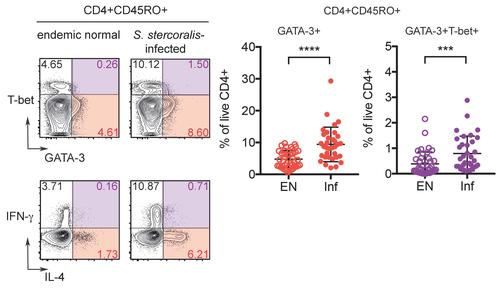Th2/1 hybrid cells in nematode-infected patients and mice
Th2/1 hybrid cells in Strongyloides stercoralis-infected patients from South India. (Click on the image for a detailed legend.)
Image Credit: Institut für Immunologie
Th2/1-hybrid cells stably co-expressing the lineage-specifying transcription factors and cytokines of Th2 (GATA-3, IL-4) and Th1 cells (T-bet, IFN-g) are induced in experimental helminth infections (Peine et al. PLOS Biology, 2013). In cooperation with Dr. S. Babu (NIH Research Centre, Chennai, India) we analysed blood cells from patients infected with the threadworm Strongyloides stercoralis. Worm-infected patients show significantly increased numbers of GATA-3+ Th2 cells as well as GATA-3+T-bet+ co-expressing cells (figure). IL-4+IFN-g+ Th2/1-hybrid cells are detectable, which, compared to murine Th2/1 hybrid cells, express very high amounts of IFN-g and low levels of GATA-3 (Bock et al. Frontiers CIM, 2017)
Selected publications:
- Peine, M., S. Rausch, C. Helmstetter, A. Fröhlich, A. N. Hegazy, A. A. Kühl, C. G. Grevelding, T. Höfer, S. Hartmann, and M. Loehning. 2013. Stable T-bet+GATA-3+ Th1/Th2 hybrid cells arise in vivo, can develop directly from naïve precursors, and limit immunopathologic inflammation. PLoS Biology, 11:e1001633.
- Bock, C.N., S. Babu, M. Breloer, A. Rajamanickam, Y. Bhootra, M.-L. Brunn, A. A. Kühl, R. Merle, M. Löhning, S. Hartmann, S. Rausch. 2017. Th2/1 hybrid cells occurring in murine and human strongyloidiasis share effector functions of Th1 cells, Frontiers in Cellular and Infection Microbiology, doi: 10.3389/fcimb.2017.00261.
Associated scientists: Dr. Sebastian Rausch, Cristin Bock, Nicole Affinass.
Third-party funds: DFG GK 2046, Project B5.
